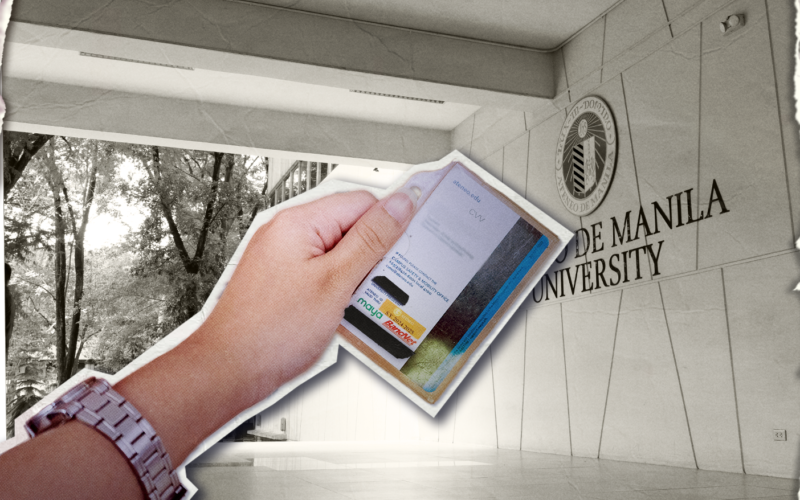Admission into the Ateneo, with all its demands and requirements, can be quite challenging.
First, one must pass the difficult Ateneo College Entrance Test (ACET) and compete against a pool of more than 20,000 students to secure a slot in the university. For the students that are accepted, there is another issue that must be settled before enrolling: The tuition fee. According to the research of AJ Bolando from The Philippine Star, the Ateneo has the most expensive tuition fee at P3,276.55 per academic unit. Compared to other universities, such as De La Salle University and University of the Philippines-Diliman (P2,363 and P1,500 per unit, respectively), the financial requirement to enroll in the Ateneo can be unattainable for many students and their families.
Luckily, the Loyola Schools (LS) offers various scholarships to deserving students. These scholarships are given on three bases: Academics, athletics or financial need. Academic scholarships are not applied for; they are determined by the student’s score in the ACET. Athletic scholarships are given to athletes who are chosen by the College Athletics Office. Through the Ateneo College Scholarship Program, financial aid scholarships give “deserving but financially challenged” students assistance through tuition grants, book and transportation allowances, and dormitory assistance. Financial aid is also given in 25%, 50%, 75% and 100% Tuition and Fees grants, depending on the student’s needs.
When it comes to financial aid, however, how does the university determine how much assistance they give?
Deciding grants
Julia Morata, the assistant to the director for Scholarships in the Office of Admission and Aid (OAA), explains how the process of applying for financial aid works. Students who wish to apply for financial aid need to fill out the application form and submit all the required documents. It is only then that the Committee on Admission and Aid processes all of the applications.
The Committee on Admission and Aid is a group composed of faculty selected by the deans and the vice president of the LS. This committee changes every year. Morata clarifies that, this year, the scholarship committee is composed of OAA Director Jumela Sarmiento, PhD, Morata, and four other faculty members.
The number of scholarships granted is based on the OAA’s budget for financial aid that year. “Before we process the applications… Halimbawa, we say we can give 200 full Tuition and Fees grants. Based on the applications we receive, a student who applies may be given a scholarship, may be put on a waiting list, or may not be given a scholarship,” she says.
Having a fixed budget may present some problems, like prioritization of what type of scholarship to give out. Prioritizing giving 100% Tuition and Fees grants means being able to sponsor students who cannot otherwise study in the Ateneo—but it also means sponsoring less scholars all in all. On the other hand, if the office prioritizes giving 25% Tuition and Fees grants, then more students will be sponsored—but less of the kind of students who truly cannot afford the Ateneo tuition.
To answer this, the OAA clarifies that they do not prioritize any kind of grant and that the office decides what grant to give based on necessity. How the OAA allocates its budget is solely dependent on the scholars who deserve to be in the Ateneo and what their financial needs are.
Those who are granted scholarships may receive the following benefits: Tuition fee waivers, dormitory allowance, books allowance and transportation allowance. However, she clarifies that the OAA grants scholarships based on necessity. “Depending on their need, ang lowest [grant] diyan could be a 25% tuition grant. We base the decision on each of the applications depending on the resources of the family, based on the documents submitted,” Morata says.
Proving the need
Given that the OAA has a limited budget for scholarships, applications tend to be competitive. In order to ensure that these scholarships are given to students who really need them, the OAA requires applicants to submit a library of documents to prove their family’s financial capability. These include a “detailed and well-written” personal letter from the parents about the family’s financial situation and need for assistance, Certificate of Employment and Compensation, and annual Income Tax Return forms. Aside from these documents, applicants are even required to send photocopies of their electric bills, credit card billing statements and a clear photo of their permanent residence and kitchen.
“If we find any inconsistencies in these documents, we either decide to put our decision on wait or to say no. Based on the documents that they submit to us, we decide whether this applicant needs financial assistance or not,” says Morata.
However, she emphasizes that the OAA does not just take into consideration the resources of a family. A scholar, she says, should have “good ACET results and consistent academic performance in high school.” The academic component in the application process is in light of the 700 to 900 students that apply for scholarships every year. “We can only give to around 200 to 250. So [we] select the top [scorers] in the ACET, the top in their schools.”
Faking it
With the nearly one thousand applicants that the OAA processes every year, it is not surprising that there are some students who apply for scholarships when their families have the financial capacity to pay for themselves. “You may have heard of the term ‘fake scholar,’” Morata says. She explains that that is the term some scholars use for students who are given financial aid when they can actually afford the Ateneo tuition.
However, Morata defends that the thorough process of the OAA prevents this from happening and also has measures to counter it. For instance, every year, the financial aid applicants need to update the documents they submitted in their original application. This measure recognizes that the financial resources of a certain family can change year by year. Based on what is resubmitted, scholarship grants can be increased or decreased depending on the scholar’s need.
With measures like this put in place, Morata assures that the problem of fake scholars is quite rare. “I’ve been here for 30 years. I can only recall mga two or three times na a particular decision has been questioned. Someone from the province called us up and asked why a certain student from that province was given financial assistance when they, in fact, own this and that,” she recalls.
However, some scholars have a different opinion. Jessica*, a sophomore financial aid scholar, says that there are fake scholars in Ateneo today. “Iyong lifestyle kasi nila, makikita mo na kaya nilang maglabas ng pera anytime. Ang hindi fair doon [ay] may mga taong kilala rin ako na deserving [of scholarships] naman dahil, halimbawa, nagkasakit ang magulang nila or nagkaproblema bigla sa pamilya, pero 25% or 50% nalang ‘yong nagra-grant sa kanila (The lifestyle of some scholars show that they can actually afford to spend a lot of money anytime. What is not fair is I know people who are deserving of scholarships because their parents are sick or they have family problems, and yet only 25% or 50% [Tuition and Fees] is granted to them),” she says.
Jessica explains that these fake scholars could possibly defraud the system by omitting information that could indicate their family’s financial situation. “Hindi naman lahat ng bagay ilalagay mo. Halimbawa, kung pupunta ka ng concert or something, siyempre hindi mo na ‘yan ilalagay, ‘di ba? I guess walang system ang OAA para ma-identify ‘yong mga ganung luxury ng mga tao (You do not disclose all things. For example, if you attend a concert or something, you would not disclose that [on the documents], right? I guess the OAA does not have a system that that can identify those kinds of luxuries),” she says.
The OAA only conducts investigations when information questioning the legitimacy of an application is given to them. However, only tips from people who are “known” to the OAA are accommodated. Morata explains how, sometimes, the OAA receives anonymous tips about fake scholars; she says that these tips are not taken seriously.
Jessica adds that fake scholars are indeed rare, but the fact that they exist in the first place is already a problem. For Jessica, though, there is only so much the OAA can do: The answer to the problem is for the students seeking financial aid to be honest in their documents.
Scholars say
To most scholars, the process that the OAA implements to decide who gets financial grants is fair.
Giles De Jesus, who is a management-honors sophomore and a 50% Tuition and Fees financial aid scholar, says, “[The OAA] really [looks] at what goes on in the life of a student before they agree to give him or her the scholarship.” He says that the OAA’s close inspection of a potential scholar’s life really prevents students from abusing the financial aid.
Andrea Denise Ng, another management-honors sophomore whose scholarship she declined to disclose, agrees with him. She adds that the office’s asking for documents is “justifiable,” despite the inconvenience of acquiring the documents.
Despite the efficiency and justness of the process, there is still room left for a little improvement. De Jesus shares his experience of trying to take some classes in advance. “I wanted to advance subjects in summer, but I was told that they wouldn’t cover the advanced classes, only the required ones,” he says. “That made it hard for me to actually take the classes I wanted.”
Briefly, Ng mentions that an increase in the amount of available scholarships for incoming students will also be beneficial.
Management sophomore Shane Nicole Remate, a 100% Tuition and Fees financial aid scholar, says that she feels that the Ateneo is a good place for scholars. “[The OAA checks up] on you every now and then to see how you’re doing academically and if there are personal problems that could affect your performance in school. They really put in the effort to get in touch with their scholars on a more personal level,” she says.
Adding to this, she also mentions that Ateneo Gabay, a student organization for scholars, makes sure to provide its members with “a sense of security within the campus” through talks and events that aim to give them guidance.
With tuition prices increasing every year, the cost of an Atenean education has never been higher. With inflation and rising operational costs, it does not seem that this trend will stop. Despite this, the Ateneo College Scholarship Program ensures that intelligent, well-deserving but financially struggling students can enjoy four years in the Ateneo without having to shoulder the financial burden that comes with it.







